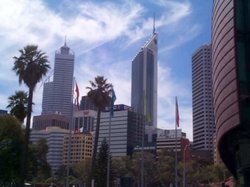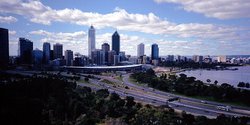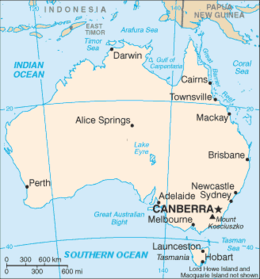Perth, Western Australia
|
|
- For other cities named Perth, see Perth.
Perth is the state capital city of Western Australia, the largest state in Australia by size. In June 2003 the Perth Metropolitan Area had an estimated population of 1,433,217, making it the fourth largest city in Australia. Perth is located at Template:Coor dm.
| Contents |
Geography
WestAusMap-doton-Perth.png
Location of Perth, Western Australia
Perth is set on the Swan River, so named because of the native black swans. It is a sprawling city, extending to Joondalup in the north, Mandurah in the south and Mundaring in the east. The coastal suburbs take advantage of Perth's oceanside location and clean beaches. To the east, the city is bordered by a low escarpment called the Darling Scarp. Perth is on generally flat, rolling land - largely due to the high amount of sandy soils and deep bedrock.
In recent years, climate change has resulted in reduced rainfall in the region, reducing inflow into dams by two thirds over the last 30 years. The lower runoff into Perth's dams and groundwater supplies, coupled with Perth's relatively high population growth, has caused concerns that Perth will be "out of water" within ten years. The Western Australian State Government has responded by introducing mandatory household sprinkler restrictions in the city. The State Government has also begun the process of constructed a relatively expensive sea water desalination plant in Kwinana (expected to be finished in late 2006), and is considering other solutions including piping water from the Kimberley or extracting water from the Yarragadee Aquifer in the southwest of the state.
The Perth city skyline displays the economic prosperity the state has enjoyed in the past 20 years. The city's tallest building, Central Park, is according to some ranking systems the fourth tallest building in Australia.[1] (http://www.emporis.com/en/bu/sk/st/tp/co/?id=100012)
The Perth metropolitan area includes over thirty local governments (cities, towns and shires). These include Fremantle, Bayswater, Canning, Stirling, Gosnells, Nedlands, Peppermint Grove, Claremont, Victoria Park and Armadale. See the list of Perth suburbs and the Local Government Areas of Western Australia for a comprehensive list.
History
Although the British Army had established a base at King George Sound (later Albany) on the south coast of Western Australia in 1826 — to forestall rumoured annexation by France — Perth was the first full scale settlement by Europeans in the "western third" of the continent. The town was established in 1829, as the capital of the Swan River Colony, a free settler colony. In 1850, as Western Australia, it became as a convict colony, at the request of farming and business people who wanted cheap labour.
The name Perth was chosen in 1829 by James Stirling. Stirling, a Scot, implemented the wish of Sir George Murray, Secretary of State for War and the Colonies, that the settlement be named after Perthshire, which was his birthplace as well as his parliamentary seat in the British House of Commons. On August 12 that year, Mrs Helen Dance cut down a tree to mark the day of the founding of the town.
In 1901, the colony joined the Federation of Australia. The city has prospered as a result of repeated mining booms, especially for gold, iron ore, nickel, and alumina: Western Australia is rich with mineral resources.
People
Many Perth residents consider their city to be egalitarian and relaxed, with a relatively large middle class and a suburban lifestyle; however, as with all large cities, Perth does have pockets of extreme wealth and poverty. The population is easy-going and friendly, but can be parochial, especially towards the "Eastern States" which are often viewed with deep, but usually jocular, suspicion. This attitude is fuelled by the Eastern States' view of Perth as a "backward" civilisation, but can be mainly attributed to Perth's isolation — reflected in the widely-held belief that Perth is "the world's most isolated capital city". (There is some truth in this: for example, travelling to the closest major capital to Perth (Adelaide), represents a travel time of three hours by commercial flight. There are, however, other candidates for the title, including Honolulu.)
Because Fremantle was the first landfall in Australia for migrant ships coming from Europe in the 1950s and '60s, Perth experienced an influx of British, Italian and Greek migrants. More recently, large-scale immigration to Perth by air from the UK has continued, giving Perth the highest-proportion of British-born residents of any Australian city. Some suburbs in southern Perth are up to 20% British by birthplace. There has also been a substantial settlement from South Africa, mainly of European-descended South Africans. Perth also has substantial immigrant communities from South East Asia such as Malaysia, Singapore, Hong Kong, Indonesia, China and India. The Indian community includes a substantial number of Parsees who emigrated from Bombay. There is also a large community of immigrants in Perth from New Zealand due to the geographical proximity and common heritage as commonwealth countries.
Yanchep_sunset.jpg
Sport
The most popular spectator sport in Perth is Australian Rules football. Two teams in the Australian Football League (AFL) are based in Perth: the West Coast Eagles and the Fremantle Football Club (or "The Dockers").
Every summer the Australian cricket team plays a test match and one day international matches at the WACA ground, which is also home to the state cricket team, known as the Western Warriors.
Perth is also home to popular soccer team Perth Glory, which has recently been added to the potentially lucrative A-League after the re-formation of Australian Soccer structure.
Perth is also home to the annual Hopman Cup tennis tournament, the annual Avon Descent whitewater event, and the annual Rally Australia. In 2006, Perth will be the home of the Western Force, a new franchise in the Super 12 rugby union competition (which will become the Super 14 with the addition of the Force and a team in South Africa).
Perth also sports a team in the National Basketball League, the Perth Wildcats, who are one of the most successful teams in the league's history. However, the popularity of basketball as a spectator sport in Australia has sharply declined since the early 1990's.
Perth is very conducive to an outdoors lifestyle, and this is reflected in the wide variety of sports available to citizens of the city.
Education
Although a relatively medium sized city, Perth is home to four public universities and one private: the University of Western Australia, Murdoch University, Curtin University of Technology, Edith Cowan University, and the University of Notre Dame Australia. The 90 year-old University of Western Australia in particular is renowned as one of Australia's leading research institutions. The university's monumental neo-classical architecture, most of which is carved from white limestone, is a notable tourist destination in the city. Curtin University of Technology is the successor to the Western Australian Institute of Technology WAIT. Murdoch University was created from land held by the UWA in the late 1970s. Edith Cowan University is the newest public university established back in the early 1990s to cope with tertiary education needs in the north west metropolitan area of Perth. The University of Notre Dame Australia was established in 1990 and was the first Catholic university in Australia.
Education in Western Australia consists of one year of pre-school, followed by seven years of primary school education, and five years of secondary education. The final two years of secondary education are not compulsory, and often students opt to substitute them for TAFE vocational education, or regular employment. The students that stay on in the final two years usually sit for the Tertiary Entrance Examination in order to be eligible to study at university.
Tourist attractions in and around Perth
Swan_river.jpg
A sun-baked city that can go weeks or even months without substantial rainfall, one of Perth's main attractions lies in the pristine quality of its beaches. Unbroken stretches of golden sands run the entire length of the city's coastal suburbs. While not unlike the beaches of the Gold Coast in Queensland, Perth has not yet experienced the same level of commercialisation and development, and hence degradation, that plagues other such naturally rich Australian urban environments.
The centre of Perth is located on the northern bank of the Swan River, and is roughly divided into three parallel sections.
- the central business district, closest to the river, and which runs along St Georges and Adelaide Terraces,
- the retail district, which has its focus on the Hay and Murray Street Malls, and
- the entertainment and cultural precinct, known as Northbridge.
Perth-park.jpg
Kings Park sits upon a large hill (Mt Eliza) overlooking the CBD. Four times larger than New York's Central Park, Kings Park contains Perth's botanical gardens as well as vast tracts of natural bushland. During spring, Kings Park bursts into a world-class display of wildflowers, which is a popular tourist attraction. In August 2003, the Lotterywest Federation Walkway was opened in Kings Park. It is a 620m long elevated walkway through the treetops, providing a remarkable bird's eye view of the park and gardens as well as sweeping views of the Swan River.
Perth is a very green city, with an abundance of parks and tree-lined boulevards.
The Perth Zoo is across the Swan River in South Perth, accessible from the city by either the Narrows Bridge or by ferry from the Barrack Street Jetty.
The Swan Bells is a towering new bell tower siting on the edge of the Swan River. A copper structure representing the sails of a ship, it houses old bells from the church of St Martin-in-the-Fields (of nursery rhyme fame), which were a gift from the United Kingdom to the people of Australia on the occasion of Australia's 200 year anniversary of colonisation. It was opened to the public in 2001. The government of Western Australia took a significant amount of criticism for creating the Bell Tower; it was said that the significant funding allotted for the project (millions of dollars) could have been better placed into the faltering health and education systems, and that the structure could have been better designed aesthetically.
The Perth Convention Exhibition Centre opened in September 2004. Situated on the river foreshore, only a short walk from the CBD, the Centre is WA's only purpose built convention, exhibition and meeting centre. It can cater for functions of up to 2500 delegates. The Centre is expected to attract increased tourism for the state. It is jocularly referred to as 'The Hayshed', because of its flat and extended design.
There are a few islands off the coast of Perth, notably Rottnest Island, a significant tourist attraction. Other nearby islands include Garden Island (home to a naval base), Carnac Island, Seal Island and Penguin Island. The deep shipping channel between Perth and these islands is called Gage Roads, the site of the America's Cup yachting challenge in 1987.
The historical port city of Fremantle is located at the mouth of the Swan River, and is home to many attractions. Most notable of these is the mammoth newly-constructed Western Australian Maritime Museum. Located on the dock at Victoria Quay, the museum houses Australia 2, the yacht which won Australia the America's Cup in 1983. Also in Fremantle is the Maritime Museum shipwreck galleries, with recovered artifacts and part of the hull of the shipwrecked Dutch ship Batavia, from hundreds of years ago.
Perth is home to Australia's largest underwater walk-through aquarium, AQWA (The Aquarium of Western Australia). Located at Hillarys Boat Harbour, this attracts large numbers of international tourists.
Perth is served by Perth Airport and Jandakot Airport.
Perth is also the hometown of the Special Air Service regiment, Australia's elite military unit. The SAS Barracks are located in Swanbourne. Swanbourne is also home to a nude beach.
Weather
Perth summers are generally hot and dry, with February generally being the hottest month of the year. The hottest ever recorded temperature in Perth was 46.2C (115F) on 23rd February 1991. Winters are cool and moist, though winter rainfall has been declining in recent years. The official temperature for Perth has never quite reached zero celsius, and even in winter maximum daytime temperatures only occasionally fall below 16C (60F).
Sister cities
Perth has a number of sister cities. They are:
- Kagoshima, Japan, established 1974
- Houston, Texas, USA, established 1984
- Rhodes, Greece, established 1984
- Megisti, Greece, established 1984
- San Diego, California, USA, established 1987
- Vasto, Italy, established 1989
External links
- City of Perth government website (http://www.cityofperth.wa.gov.au/)
- 128km Radius, Perth Radar, Current Rainfall (http://mirror.bom.gov.au/products/IDR123.shtml)
- Western Australian Tourism Commission (http://www.westernaustralia.net/discover/perth/index.shtml)
- Fremantle Maritime Museum (http://www.museum.wa.gov.au/default.asp?et=2&ei=37)
- King's Park and Botanical Gardens website (http://www.kpbg.wa.gov.au/)
- Perth Convention Exhibition Centre (http://www.perthcentre.com.au/)
- Rottnest Island website (http://www.rottnest.wa.gov.au/)
- Webcams of Perth's most popular beaches (http://www.dpi.wa.gov.au/coastaldata/coastcam/live.html)
- Webcam from top of the city, looking down on the river (http://perthcam.bankwest.com.au/full.html)
| Capital cities of Australia | |||||||
|---|---|---|---|---|---|---|---|
| National | NSW | NT | Qld | SA | Tas | Vic | WA |
| Canberra | Sydney | Darwin | Brisbane | Adelaide | Hobart | Melbourne | Perth |
| Other Australian cities | |||||||
de:Perth_(Australien) es:Perth fr:Perth (Australie occidentale) he:פרת' id:Perth, Australi Barat ja:パース (オーストラリア) nl:Perth no:Perth pl:Perth (miasto w Australii) fi:Perth sv:Perth,_Australien




